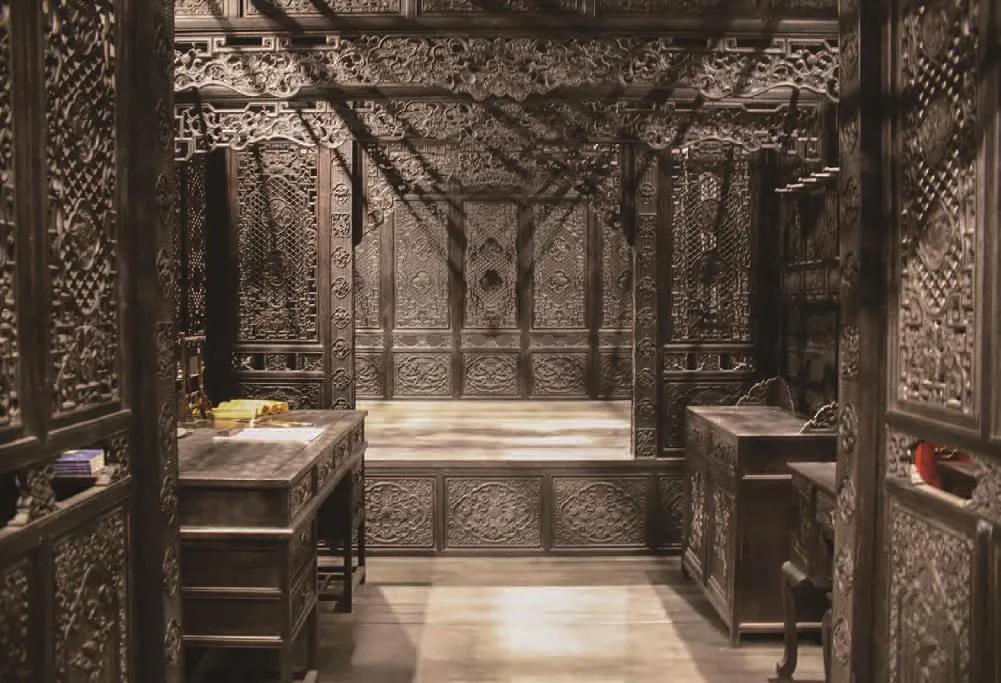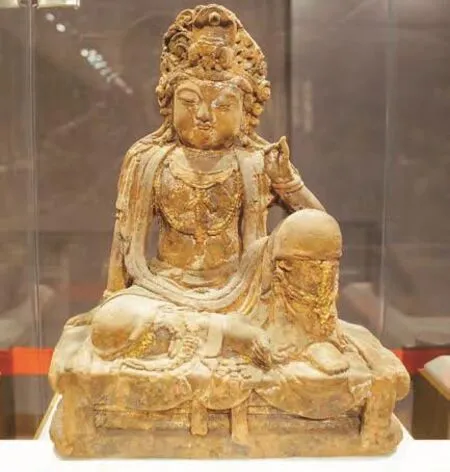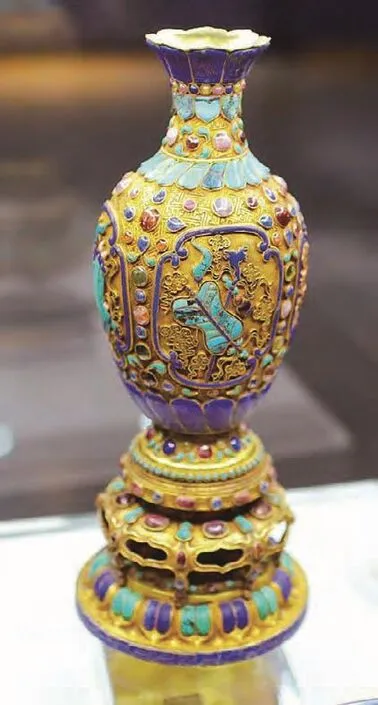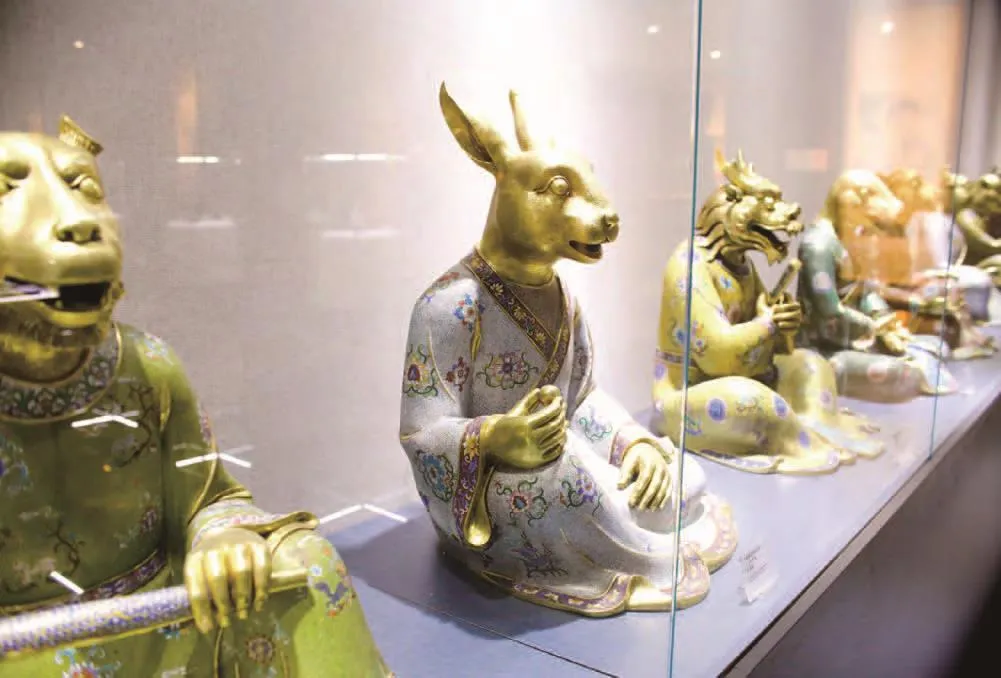The Ancient Pure Pearl in Dynamic Downtown
By Hongshao Xiaoguniang
Who can conjure up some immovable ancient antiques treasured in the everchanging high-tech Optics Valley?
Each city has its own peculiar temperament.For example, in the streets of Wuhan, you can often witness a swarming downtown area with a sleepy lane nestled in between outcroppings of supertalls; the fresh-faced business people dressed in business suits and leather shoes hurrying about their business are coupled with grey-haired residents furiously engaged in leisurely gossip. Wuhan is developing and transforming itself rapidly in a conflicting state of languid rapidity. Where commanding commerce meets deferential art, a gallery provides a tranquil oasis amid the clamorous Optics Valley.
Located near a large shopping mall, the Hangu Art Gallery has distinguished itself in its isolation from the surrounding commercial cacophony. It neighbors a cinema, and sits opposite a bank. The ancient china, scripts and paintings rest peacefully in the museum, reflecting the vicissitudes of China’s history of 5,000 years.
It is the first folk art museum established in the Optics Valley Business Circle of Wuhan.
Gilt Bronze Fan with Inlaid Multi-Jewels, Qing Dynasty
A palm-sized exquisite and elegantly crafted piece of jewelry that no woman can resist. Besides the use of traditional openwork,relief carving and inlay craft to the fan body, an indigo dotting technique was also applied. First,a small metal trowel was used to fill a narrow gap with finely ground glaze, then it was fired at 800℃, bringing out the brilliant surface colors.

Gilt Bronze Fan with Inlaid Multi-Jewels,Qing Dynasty 清代铜鎏金嵌八宝点蓝扇
Gold Wire Ganoderma Lucidum Ruyi, Qing Dynasty
Perusing the gallery, you will likely find yourself stopping to admire this ancient, luxurious jewel called Ruyi, and be unable to break from its bewitching beauty . This is truly a treasure of the Niohuru Hala clan.
Filigree inlaying was a technique employed by the ancient imperial craftsmen to make jewelry for the emperor’s concubines. The gold is stretched into gold threads and then woven into the piece. When inlay work is performed, it is necessary to hammer the gold sheet and then insert the gems.
Though I ama self-proclaimed dabbler in art, I always feel that no one can resist the temptation of visiting the Art Museum. It’s not expected that we be edified or refined by immersion in the artistry and enlightenment of the antiques, nor is it intended that we instantly become art aficionados. The art gallery is more like a dream space, a place where we can journey through time.
谁能想到瞬息万变的高科技大光谷里还藏着些不动如山的老古董
每座城市都有特殊的气质,而在武汉街头,常常能看到这样的场景,这头是繁华闹市,那边是幽暗小巷;这一边西装革履的商务人士步履匆忙,那一头婆婆爹爹结群闲聊。城市就在这样的撕裂和融合中发展变迁。当商业与艺术发生交集,她是浮躁的光谷里温柔沉淀的艺术馆。
被一大片购物中心包围的汉古艺术馆颇有些特立独行的意思,它对面是银行,身侧是电影院,馆中的古瓷字画叙说上下五千年。
它是武汉光谷商圈的第一间民间艺术馆。
清代铜鎏金嵌八宝点蓝扇
精致、典雅、美,大概没有女生能拒绝这个不足手掌大的饰物。除了扇身采用镂空、浮雕、镶嵌工艺,它还采了一种叫做点蓝的工艺,即,用金属小铲子把碾细的釉料填入丝工空隙处,经过800℃的火烧,使色彩呈现在器物表面上。
清代金累丝镂空灵芝如意
再过来看看让我们恋恋不舍的古代的奢侈品之如意,它是钮钴禄氏的珍宝。

Gold Wire Ganoderma Lucidum Ruyi, Qing Dynasty 清代金累丝镂空灵芝如意
缧丝镶嵌是古代宫廷工匠为后宫妃嫔制作首饰时用的一门技术,将金抽成细丝,以堆垒编织而成。镶嵌的时候,需要把金薄片锤打成型,再镶嵌宝石。
我是实实在在的艺术门外汉,但我总觉得,没有人能拒绝艺术馆的诱惑。并不是期待从旧物得到所谓熏陶或升华,也不打算指导谁如何欣赏展品。艺术馆更像一座造梦空间,这个梦是时光的穿越。
陶瓷、金铜造像、木器、鼻烟壶、青铜器,在工业流水线的速食时代,这些藏品有着数百年的工艺。当你进入艺术馆,置身于其中,一切都显得安谧而缓慢,像雕栏里流淌过一阵风,钟声沉落在暮色里。
这间汉古艺术馆开馆两个多月,属于私人博物馆,馆内所有藏品均由馆长谢小青先生个人捐赠,投资逾二十亿元,展示面积近三万平方米,容纳2500余件藏品,共分为六层楼。对外展示的区域有四层楼,分别为“恒臻馆”“艺珍馆”“汉古阁”和“拾遗馆”。设立在汉古艺术馆二层的“汉古阁”有500余件特色藏品,宣德青铜四大天王、清木雕市井图、明石雕水月观音、郎世宁瓷板画等皆为稀有艺术藏品。

Padauk Eight Treasures Alcove Bed Carved with Auspicious Animals, Qing Dynasty 清代紫檀瑞兽八宝千工床
In an era of mechanized, fast food culture, it is rare indeed to glimpse such historical significance; these collections as ceramics, gold and bronze statues,wood utensils, snuff bottles, and bronze wares boast hundreds of years of craftsmanship. When you enter the gallery, you will become fully immersed in the tranquil and languid rhythms.You will envision yourself being ushered into an ancient land with the sun sinking into the twilight,accompanied by soft breezes that waft through the sculpted corridors.
The privately owned Hangu Art Gallery has been open to the public for more than two months and all the collections were donated by curator Xie Xiaoqing,who invested over 2 billion yuan.The exhibition hall, occupying an area of 30,000 square meters,consists of six floors and contains over 2,500 items.

Gilt Stone Water-Moon Avalokiteshvara Status, Ming Dynasty 明代鎏金石雕水月观音佛像
There are four floors intended for public exhibitions, namely, the Hengzhen Pavilion, the Yizhen Pavilion, the Hangu Pavilion and the Shiyi Pavilion.
“The Hangu Pavilion,” located on the second floor, has a rare collection of more than 500 pieces, among which the Xuande Bronze Four Heavenly Kings, the Qing-Dynasty Woodcarving Town Drawings, the Ming-Dynasty Stone-carving Water and Moon Guanyin (Kwan-Yin) and the Giuseppe Castiglione Porcelain Paintings are all the rarest.
The collection is the heart of the art gallery, and my favorite is the thousand-worker bed.
Padauk Eight Treasures Alcove Bed Carved with Auspicious Animals, Qing Dynasty
This “thousand-worker” bed was carved and decorated by ancient architects, animal patterns, flower and plant patterns adorn all four sides, denoting good fortune. It is very sturdy, made up of more than 500 mortise and tenon joints without a single nail. It was mainly used as a wedding bed.The door is primarily decorated with mixed patterns of twisting and turning vines. The twisting pattern was considered lucky by the ancient Chinese, owing to its characteristic eternal and unending quality. The vine melon and the myriad melon are homophonous in Chinese,
馆藏品是艺术馆的心脏,我尤其喜欢千工床。
清代紫檀瑞兽八宝千工床
这具千工床,紫檀木在光下明润生辉,四周雕有建筑、动物、花卉等,寓意吉祥,整体用500多个榫卯卯合而成,不用一颗钉,非常牢固。如果用作婚床,门洞板一般会以拐纹与蔓瓜纹相结合图案为装饰。拐纹因其连绵不断,无穷不尽,曾被古人作为祥瑞之美纹。而蔓瓜与万瓜同音,喻为瓜多、子多、万代,即一代接一代绵绵不断。“千工床、万工轿、十里红嫁妆”形容的就是婚嫁民俗现象。
“千工床”在旧时是达官贵人家中的家具,费工浩大,做一张床甚至需要花费数千工人,于是叫做千工床。和现在的床板不同,千工床内配有梳妆台、书桌、挂衣架以及方凳、花架等生活用具,像一个小屋子。小时候在奶奶家就见这种床,我喜欢把门关上,披着被子扮仕女。
清代紫檀龙椅
紫檀龙椅是特色,紫檀龙纹龙椅,紫檀木制,它通体满雕,以透雕为主,几无留白,并以龙纹作为主题装饰。
背后的紫檀屏风分作七联,边框雕琢单龙吐珠纹饰,屏心为双龙戏珠造型浮雕,典雅华贵,宫灯灯扇镂空雕龙纹,中心雕刻“寿”字纹,灯柱上浮雕蝙蝠、寿字纹。这些手工制作的雕纹,甚至比现代机器制造出的产品更典雅。

Padauk Dragon Throne, Qing Dynasty 清代紫檀龙椅
清代樟木市井图牌匾
明清时以香樟木制成的箱柜较多,但这样长3.3米、宽0.66米,一整块香樟木浮雕而成的牌匾,却十分难寻。
匾额展现了清代中早期市井生活,可以看到清时的亭台楼阁、建筑风物和人们的劳作场景,主要是“康乾盛世”人们日常生活的点点滴滴。
雍正圆明园行乐图
西方传教士郎世宁深受乾隆帝的欣赏,被誉为“宫廷画家”,这套《雍正十二月行乐图》属于瓷板画,是在平素瓷板上用特殊颜料手工绘画、上釉,再经高温烧制而成的一种平面陶瓷工艺品。清代瓷艺迅猛发展,这种把纸绢上的中国画移植到瓷器上的艺术品,受到人们的青睐。
雍正时期,圆明园修建一新之后,雍正皇帝经常在此居住并办理公务。这12幅行乐图分别为“正月观灯”“二月踏青”“三月赏桃”“四月流觞”“五月竞舟”“六月纳凉”“七月乞巧”“八月赏月”“九月赏菊”“十月画像”“十一月参禅”和“腊月赏雪”,让我们依稀看到圆明园的真实面貌。
看完汉古阁,也可以逛逛其他楼层,一样有惊喜,一楼大厅最显眼的是一套花梨木龙椅宝座,龙椅、屏风、宫灯、地台形成一组陈设,庄重凝雅。三楼、负一楼也陈列了几百件令人神往的艺术佳品。瓷器、玉器、漆器、竹木器、鼻烟壶等门类齐全,精品众多,不一而足。
旧物里凝聚着时光,从艺术馆出来时,再看车如流水马如龙,一阵恍惚。现实是门前的施工热火朝天,是对面银行里排队咨询的焦躁不安,是影院的爆米花和甜腻的奶茶可乐。艺术馆却保有一份做梦的权利,它以遗世独立的骄傲姿态,成为城中的灵韵,让城市变得深沉而厚重。◆

Emperor Yongzheng’s 12 Joyful Months in the Yuanmingyuan Imperial Garden 雍正圆明园行乐图
(摘自微信公众号better;图/santa及汉古艺术馆)and denote productivity and plenty. The melon vines are used figuratively to suggest the idea,more melons means more seeds to multiply and replenish the earth, thus symbolizing more and continuous birth from one generation to the next. The folk rhyme, “Thousand-worker bed,ten-thousand-worker sedan and ten-mile bright red dowry” best mirrors the marriage ceremony at that time.

Gilt Copper Cloisonné Vase with Inlaid Multi-Jewels, Qing Dynasty清代铜鎏金嵌八宝蓝赏瓶
In the old times, the thousand worker bed was a necessity in the families of nobles and officials.Its name was inspired by the sheer labor intensiveness it took to create the piece. Thousands of workers were commissioned to craft such a costly and opulent bed. Unlike its modern counterpart, the ancient bed included dressers, desks, hangers and other tools, such as square stools and flower racks, making it look like a small room. When I was a kid, I saw this type of bed at my grandmother’s house, where I liked to close the door and drape a quilt around my shoulders,pretending that I was an ancient beauty.
Padauk Dragon Throne, Qing Dynasty
The padauk Dragon Throne is characterized by its dragon designs. It is made of padauk,and filled from top to bottom with carvings primarily of openwork.There is little use of negative space, and the main carvings feature dragons.
The screen in the chair back is divided into seven parts. The frame is decorated with a single dragon carrying beads in its mouth, and the screen center is embroidered with double dragons playing with beads, the piece is both elegant and luxurious.
The lantern lamp fan was hollowed out to carve the dragon pattern, the character for “longevity” (called “shou” in Chinese) is carved into the center and the images of bats along with the character for longevity are embossed on the lamp posts.These hand-made carvings are even more elegant than the products made by modern machines.
Camphor Wood Plaque with Market Place Drawing, Qing Dynasty
In the Ming and Qing Dynasties,there were more cabinets made of camphor wood, but today it is very hard to find an embossed plaque made entirely from a piece of camphor wood, which is 3.3 meters long and 0.66 meter wide.The plaque vividly portrays small-town life in the early-to mid-Qing Dynasty. One can see a snapshot of people’s daily life in the Qing Dynasty, “Golden Age under the Kangxi and Qianlong Emperors,” embodied in the images of pavilions, terraces and towers, architecture and scenes of people living and working.
Emperor Yongzheng’s 12 Joyful Months in the Yuanmingyuan Imperial Garden
Giuseppe Castiglione, an Italian missionary, was deeply appreciated by Emperor Qianlong and was honored as the “Court Painter.” This set of “Emperor Yongzheng’s 12 Joyful Months”belongs to the porcelain portrait.It is a flat, hand-made ceramic painted and glazed with special pigments on the plain porcelain plate, which was then fired at high temperature. This porcelain art flourished in the Qing Dynasty.This art form, which transferred Chinese paintings on paper and silk to porcelain, was very popular at that time.
During Emperor Yongzheng’s reign, he often resided and handled official duties in the newly constructed Yuanmingyuan Garden. These 12 pictures named, “Watching the Lanterns in January,” “An Outing in February,” “Admiring Peach Blossoms in March,” “Feasting on the Waterfront in April,”“Racing Boats in May,” “Enjoying the Cool in June,” “Celebrating the Double-Seventh Festival in July,” “Viewing the Full Moon in August,” “Appreciating the Chrysanthemums in September,”“Painting the Pictures in October,” “Meditating in November” and “Savoring the Snow in December” best describe the true characteristics of the Yuanmingyuan Garden.
After visitingthe Hangu Pavilion, you can walk around the other floors. The most prominent part of the hall on the first floor is a set of palisander dragon thrones. The throne, screen,palace lantern and platform form a set of furnishings, which are dignified and elegant. On the third floor and on the basement there is also hundreds of fascinating art treasures, including a full range of boutiques such as porcelains, jade wares, lacquerwares, bambooand-wood wares and snuff bottles.
In the presence of antiques like these, time itself seems to stand still. Walking out of the art gallery, I feel dazzled by the sudden heavy flow of traffic on the streets. The construction site in front of me where a new supertall is being thrown up at full speed and the crowd queuing up in the bank opposite seem steeped in heavy anxiety. The mass-produced popcorn in the cinema and the sugary milk tea at the corner street store are selling like hotcakes as usual,but the art museum offers us the rare privilege of stepping into in a totally different world. For Wuhan, the inspiration the gallery brings to the hustling, bustling city and its potential to provide cultural abundance is a point of pride.◆

Cloisonné Chinese Zodiac (Twelve), Qianlong Reign, Qing Dynasty清 乾隆 铜胎掐丝珐琅文十二生肖

